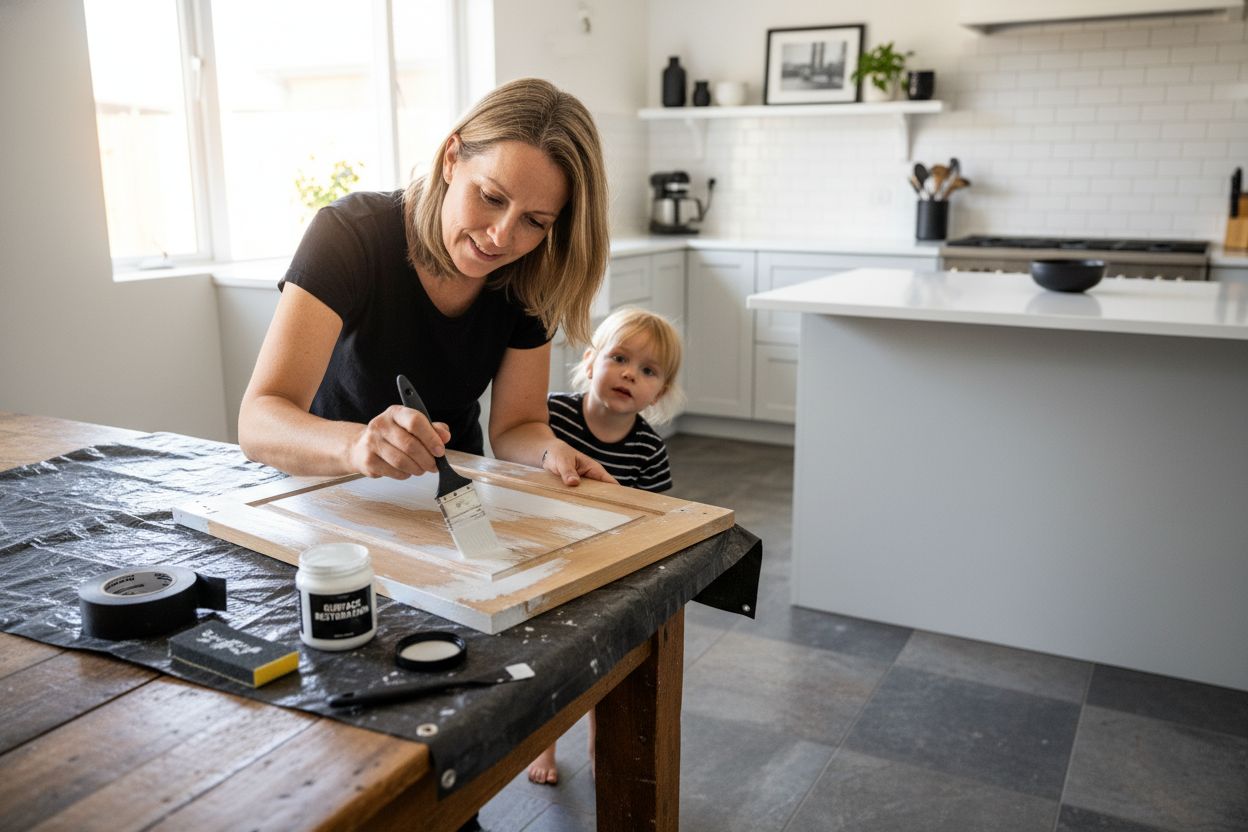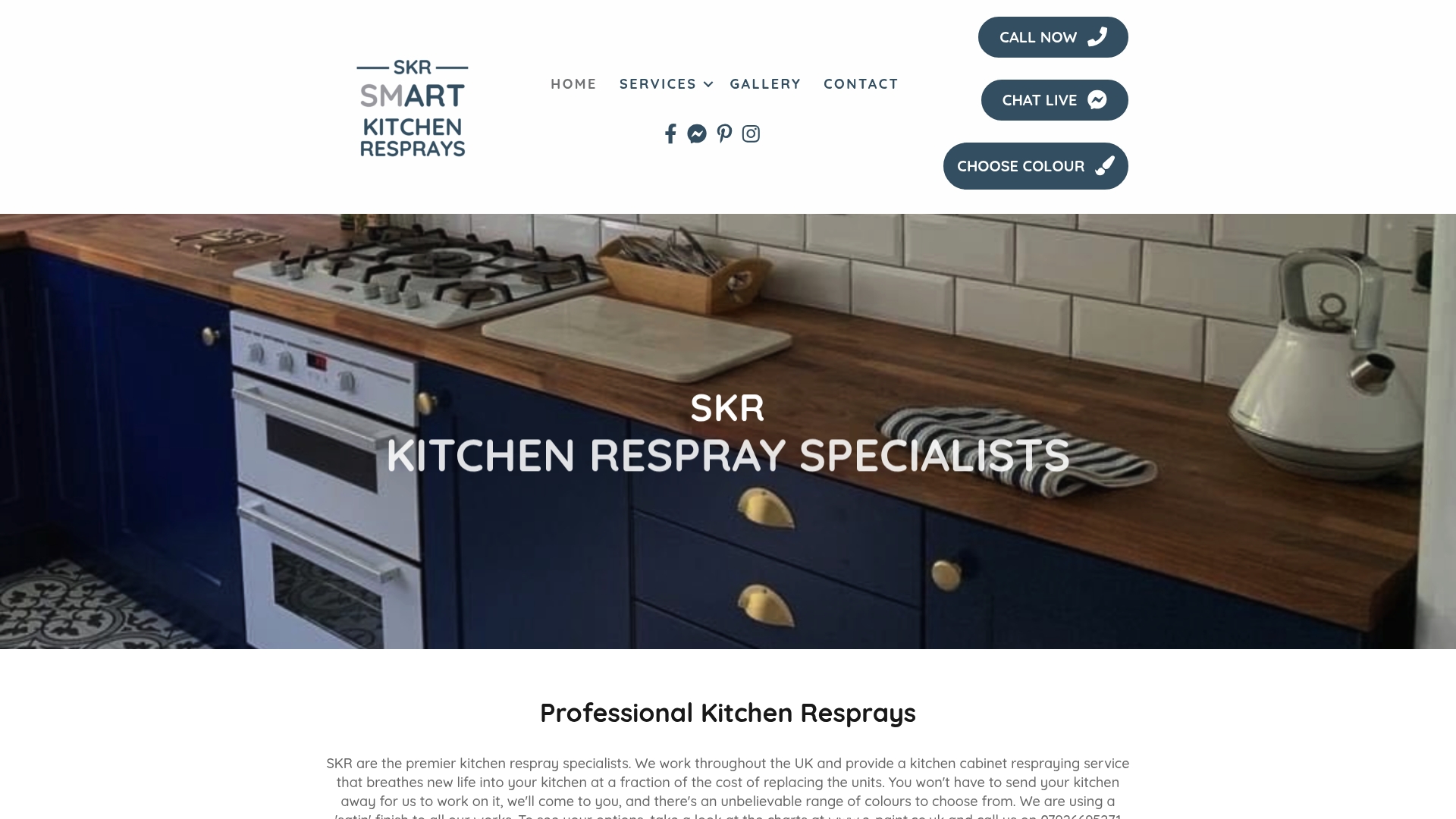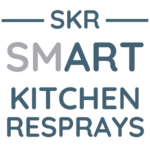Understanding Kitchen Touch-Ups: A Homeowner’s Guide
Kitchen touch-ups might seem like a small detail, yet they can redefine the heart of your home without major upheaval. Most homeowners are shocked when they realise that targeted touch-ups can cost as little as 10 to 20 percent of a full kitchen renovation. It sounds unlikely, but this quick fix can actually add real value to your property and keep your kitchen looking fresh for a fraction of the price.
Table of Contents
- What Are Kitchen Touch-Ups And Why Do They Matter?
- The Importance Of Regular Kitchen Maintenance
- Common Areas In The Kitchen That Need Touch-Ups
- Choosing The Right Materials For Touch-Ups
- Understanding The Impact Of Kitchen Touch-Ups On Home Value
Quick Summary
| Takeaway | Explanation |
|---|---|
| Kitchen touch-ups save money | Touch-ups cost 10-20% of full renovations, offering a budget-friendly way to refresh kitchens. |
| Regular maintenance prevents damage | Proactive care helps avoid costly repairs by addressing small imperfections before they escalate. |
| Target high-traffic areas for attention | Focus on surfaces like worktops and cabinet fronts that see the most wear and tear. |
| Choosing the right materials is crucial | Proper material selection enhances durability and appearance, making touch-ups more effective and long-lasting. |
| Boost your home value with touch-ups | Well-maintained kitchens can add up to 10% to property value, making touch-ups a smart investment. |
What are Kitchen Touch-Ups and Why Do They Matter?
Kitchen touch-ups are strategic restoration techniques designed to renew and revitalise existing kitchen surfaces without undertaking a complete renovation. These targeted interventions address minor wear, cosmetic damage, and aesthetic deterioration, offering homeowners a cost-effective alternative to full kitchen replacements.
Understanding Kitchen Surface Restoration
Kitchen touch-ups encompass various technical processes aimed at restoring surfaces to their original condition or improving their appearance. These methods can include surface respraying, paint touch-ups, chip repairs, and targeted refinishing techniques that breathe new life into existing kitchen elements.
The primary goal of kitchen touch-ups is maintaining aesthetic appeal while extending the functional lifespan of kitchen surfaces. By addressing minor imperfections early, homeowners can prevent more significant structural damage and maintain their kitchen’s overall visual integrity. Explore our professional kitchen resprays for comprehensive surface restoration solutions.
Economic and Aesthetic Benefits
Touch-ups provide substantial advantages for property owners seeking practical home improvement strategies. The economic benefits are particularly compelling:
- Significantly lower cost compared to complete kitchen replacements
- Minimise disruption to daily household routines
- Rapidly improve kitchen aesthetics with minimal intervention
According to research from HomeServe, kitchen renovations can cost upwards of £10,000, whereas targeted touch-ups might represent only 10-20% of that expense. This makes touch-ups an attractive option for budget-conscious homeowners looking to refresh their kitchen’s appearance without undertaking a major renovation project.
![]()
Ultimately, kitchen touch-ups represent a strategic approach to home maintenance, balancing aesthetic renewal with practical, cost-effective solutions that preserve and enhance your kitchen’s visual and functional qualities.
The Importance of Regular Kitchen Maintenance
Regular kitchen maintenance represents a proactive approach to preserving the functionality, aesthetic appeal, and long-term value of one of the most critical spaces in a home. By implementing consistent care strategies, homeowners can significantly extend the lifespan of their kitchen surfaces and prevent costly future repairs.
Preventing Structural Degradation
Kitchen surfaces endure significant daily stress from cooking activities, moisture exposure, temperature fluctuations, and constant use.
Regular maintenance acts as a protective shield against progressive deterioration. Small imperfections like minor chips, scratches, or paint wear can rapidly escalate into more substantial structural damage if left unaddressed.
Maintenance involves carefully monitoring surface conditions, identifying potential weak points, and intervening promptly. Learn more about our professional kitchen maintenance services to understand how targeted interventions can preserve your kitchen’s integrity.
Financial and Aesthetic Preservation
Consistent kitchen maintenance offers substantial economic advantages beyond simple cosmetic improvements. The financial implications of neglecting kitchen surfaces can be significant:
- Prevents expensive full surface replacements
- Reduces long-term repair and restoration costs
- Maintains property value and aesthetic appeal
- Minimises unexpected maintenance expenditures
According to research from the Property Care Association, proactive maintenance can reduce potential repair costs by up to 40%, making it a financially prudent strategy for homeowners.
Long-Term Kitchen Health
Beyond immediate visual improvements, regular maintenance contributes to the overall health of kitchen environments. Consistent care helps prevent moisture accumulation, inhibit potential mould growth, and maintain hygienic surfaces. This approach not only preserves the physical infrastructure but also supports a clean, safe cooking environment for households.
By integrating systematic maintenance practices, homeowners transform kitchen care from a reactive task into a strategic, preventative approach that safeguards both their property investment and daily living experience.
Common Areas in the Kitchen That Need Touch-Ups
Kitchen surfaces are constantly exposed to various forms of wear and tear, making certain areas more susceptible to damage and requiring targeted maintenance. Understanding these vulnerable zones helps homeowners prioritise their restoration efforts and maintain their kitchen’s aesthetic and functional integrity.
Frequently Impacted Surface Types
High-traffic kitchen areas experience more significant and frequent deterioration compared to less utilised spaces. Surfaces directly involved in cooking, food preparation, and daily interactions bear the brunt of potential damage. Explore our professional kitchen restoration services to understand comprehensive touch-up strategies.
Cabinet fronts, worktops, and splashbacks represent primary areas requiring consistent attention. These surfaces are continually exposed to moisture, heat, cooking residues, and physical contact, which can gradually compromise their original finish.
Critical Areas Requiring Periodic Inspection
Several specific kitchen zones demand regular maintenance and strategic touch-ups:
- Worktop edges and corners prone to chipping
- Cabinet door handles and surrounding areas
- Splashback regions near cooking zones
- Sink perimeters experiencing water damage
- Paint or coating areas near heat sources
According to research from the Royal Institution of Chartered Surveyors, systematic monitoring of these areas can prevent significant structural degradation and maintain surface integrity.
Understanding Surface Vulnerability
Material composition significantly influences touch-up requirements. Wooden surfaces absorb moisture differently compared to laminate or metal finishes, necessitating unique restoration approaches. Painted surfaces might require more frequent interventions, while professionally resprayed surfaces offer enhanced durability and resistance to environmental stressors.
By recognising these nuanced differences and implementing targeted maintenance strategies, homeowners can effectively preserve their kitchen’s appearance and functionality, extending the lifespan of critical surfaces through proactive and strategic touch-up interventions.
To help homeowners understand where to focus their maintenance efforts, the following table categorises common kitchen surface types and summarises their unique touch-up considerations.
| Surface Type | Typical Issues | Touch-Up Considerations |
|---|---|---|
| Wooden Surfaces | Moisture absorption, scratches | Require sealing, may need frequent refinishing |
| Laminate Finishes | Peeling, chipping | Use compatible adhesives, match pattern precisely |
| Metallic Coatings | Scratches, tarnishing | Specialised primers and anti-corrosive coatings needed |
| Painted Areas | Fading, flaking | Colour match essential, may need respraying |
| Resprayed Surfaces | Minor chips, surface wear | Enhanced durability but still need periodic inspection |

Choosing the Right Materials for Touch-Ups
Selecting appropriate materials for kitchen surface restoration requires careful consideration of multiple factors beyond simple colour matching. The right touch-up materials can significantly influence the durability, appearance, and long-term performance of kitchen surfaces.
Material Compatibility Considerations
Surface material composition determines touch-up strategy. Different kitchen surfaces demand specific restoration approaches and specialised products. Wooden surfaces, laminate finishes, metallic coatings, and painted areas each present unique challenges that require tailored material selection.
Discover our professional kitchen respray techniques to understand comprehensive material matching strategies. Professional assessment helps identify precise material requirements that ensure seamless restoration and optimal surface protection.
Key Selection Criteria
Homeowners should evaluate touch-up materials based on several critical parameters:
- Chemical resistance and durability
- Colour and finish consistency
- Adhesion properties
- Temperature and moisture tolerance
- Long-term performance characteristics
According to research from the British Coatings Federation, selecting materials with appropriate technical specifications can extend surface lifespan by up to 60% compared to inappropriate restoration approaches.
Professional vs DIY Material Selection
Professional-grade touch-up materials offer superior performance compared to standard consumer products. Specialist coatings provide enhanced adhesion, more precise colour matching, and greater resistance to environmental stressors. While DIY solutions might seem cost-effective initially, they often result in inconsistent results and potentially accelerated surface degradation.
Understanding material nuances allows homeowners to make informed decisions, balancing aesthetic requirements with technical performance and long-term kitchen surface preservation.
The table below presents a comparison between professional and DIY touch-up approaches, highlighting the primary distinctions in terms of performance and outcomes as discussed in the article.
| Approach | Advantages | Limitations |
|---|---|---|
| Professional Materials | Superior adhesion, precise colour match | Higher initial cost, requires expertise |
| DIY Solutions | Lower initial expense, accessible | Results often inconsistent, reduced durability |
Understanding the Impact of Kitchen Touch-Ups on Home Value
Kitchen touch-ups represent more than cosmetic improvements. They are strategic investments that directly influence property market perception, potential resale value, and overall home attractiveness. Understanding this relationship helps homeowners make informed decisions about kitchen maintenance and restoration.
Perception and First Impressions
Visual presentation plays a crucial role in property valuation. Potential buyers form immediate impressions based on kitchen appearance, with dated or poorly maintained surfaces potentially deterring interest. Touch-ups transform tired-looking spaces, creating an impression of well-maintained property that signals broader home care and attention to detail.
Explore our professional kitchen restoration options to understand how targeted improvements can enhance property marketability. Professional interventions demonstrate proactive maintenance, which resonates positively with potential buyers and property valuers.
Financial Value Enhancement
Touch-ups offer significant financial advantages in property valuation:
- Prevent perceived depreciation of kitchen infrastructure
- Create cost-effective alternative to full renovations
- Demonstrate ongoing property maintenance
- Improve aesthetic appeal without substantial investment
- Signal property care to potential buyers
According to research from the Royal Institute of Chartered Surveyors, well-maintained kitchens can contribute up to 10% additional value to residential properties. Strategic touch-ups represent a low-cost method of maintaining and potentially increasing home market value.
Long-Term Property Investment Strategy
Consistent kitchen maintenance represents a nuanced investment approach. Regular touch-ups prevent progressive surface deterioration, which can compound into more expensive restoration requirements. By addressing minor imperfections early, homeowners protect their property’s structural integrity and aesthetic appeal.
Touch-ups transform kitchen maintenance from a reactive expense into a proactive investment strategy, balancing immediate aesthetic improvements with long-term property value preservation.
Ready to Transform Your Kitchen Without the Stress?
If small chips, faded surfaces, or daily wear are leaving your kitchen looking tired, you are not alone. Many homeowners face these challenges but worry about the high costs and disruption of a full renovation. This is where professional kitchen touch-ups and resprays offer a targeted and economical solution. Our expertise in kitchen surface restoration, resprayed finishes, and in-situ solutions makes it easy to reclaim a fresh and modern space without starting from scratch. For more industry insights and homeowner stories, explore our Uncategorized Archives.

Why wait for minor damage to become a major expense? Trust an experienced team for a seamless transformation that boosts your home’s value and everyday enjoyment. Visit SKR Specialists to request your free kitchen assessment and discover how effortless a vibrant kitchen can be. Your new-look kitchen starts today.
Frequently Asked Questions
What are kitchen touch-ups and why should I consider them?
Kitchen touch-ups are targeted restoration techniques that refresh existing kitchen surfaces without requiring a full renovation. Consider them as a cost-effective solution to minor wear and tear, helping to maintain your kitchen’s overall aesthetic and functional qualities.
How can I identify areas in my kitchen that need touch-ups?
Look for high-traffic areas such as cabinet fronts, worktops, and splashbacks that show signs of wear, such as chips or scratches. Regularly inspect these surfaces, and address any minor imperfections promptly to prevent them from escalating into larger issues.
What are the benefits of performing regular kitchen maintenance?
Regular kitchen maintenance helps prevent structural degradation and prolongs the life of your surfaces, ultimately saving you money on expensive repairs. Implement a consistent care routine to extend the lifespan of your kitchen by up to 40%.
How do I choose the right materials for kitchen touch-ups?
Selecting appropriate materials depends on the surface composition of your kitchen. Always evaluate options based on durability, colour consistency, and moisture tolerance to ensure a successful and lasting restoration.
What impact do kitchen touch-ups have on my home’s value?
Kitchen touch-ups can significantly enhance your property’s market perception and potential resale value by maintaining a well-kept appearance. By proactively addressing minor issues, you can prevent perceived depreciation and contribute up to 10% additional value to your home.
Can I perform kitchen touch-ups myself, or should I hire a professional?
While DIY touch-ups may seem cost-effective, professional interventions often provide superior results and durability. Assess your skill level and the complexity of the repairs to determine whether to tackle the task yourself or to seek professional help.
